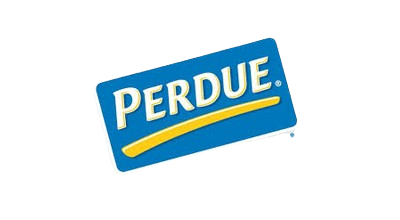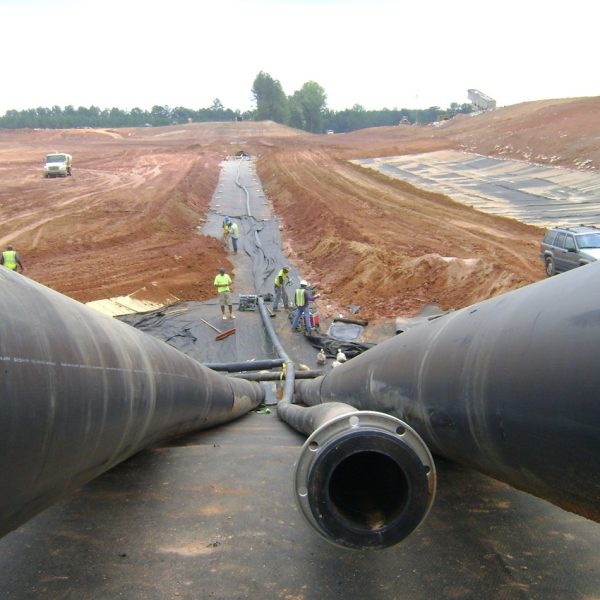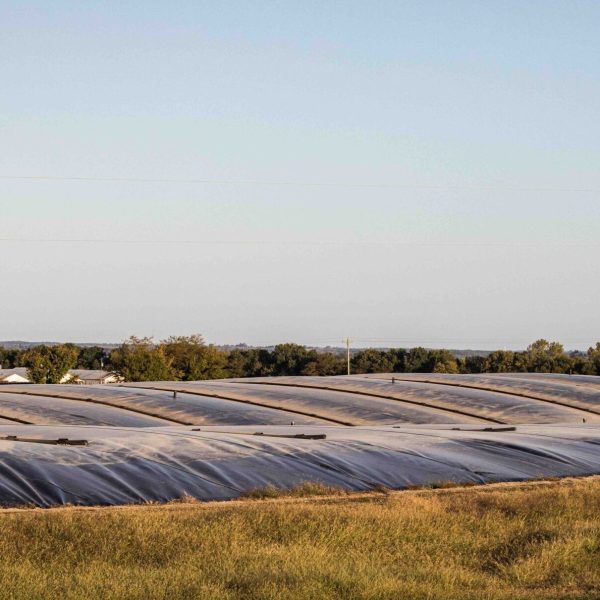Secondary Containment
Liner Installation
Plastic Fusion is a leading fabricator, supplier, and installer of high-quality containment liners for industrial, agricultural, and environmental applications. Our liners offer superior chemical resistance, durability, and leak prevention, ensuring safe containment of hazardous and non-hazardous materials in landfills, reservoirs, wastewater treatment facilities, and more.
CONTACT NOW FOR FREE CONSULTATION


















Unmatched Performance
Anaerobic Digester Covers
We design and install HDPE cover systems for anaerobic digesters and are a pioneer in anaerobic digester lagoons for biogas collection and conversion to Renewable Natural Gas (RNG).
Liner Systems
Plastic Fusion has been installing geosynthetic containment systems for more than 40 years.
Piping Systems
Our custom fabricated piping systems meet even the toughest handling requirements. Materials offer long-term chemical resistance and environmental containment.
Concrete Protective Liners
Plastic Fusion is a leader in the installation of concrete protective liners in industrial tanks and storage facilities, wastewater treatment tanks, and chemical processing plants.
Secondary Containment
Liner Installation
Plastic Fusion is a leading fabricator, supplier, and installer of high-quality containment liners for industrial, agricultural, and environmental applications.
CONTACT NOW FOR FREE CONSULTATION
Read more
What Is a Secondary Containment Liner?
A secondary containment liner is a protective barrier installed beneath storage tanks, chemical containers, or other potentially hazardous materials to prevent leaks or spills from contaminating the environment. These liners act as a safeguard in case of primary containment failure.Why Are Secondary Containment Liners Important?
Secondary containment liners are essential for preventing the leakage of hazardous substances, protecting the environment, and ensuring compliance with regulatory standards. They help contain chemicals and other dangerous materials, minimizing the risk of soil and water contamination.What Are Secondary Containment Tank Liners?
Secondary containment tank liners are specially designed barriers installed around or beneath storage tanks to contain spills and leaks. These liners are typically made from materials that resist chemicals, ensuring that hazardous substances do not escape into the surrounding environment.How Does a Primary Containment Liner Differ from Secondary Containment?
A primary containment liner is the initial barrier in direct contact with the stored material, while secondary containment refers to the outer structure or liner that captures any leaks or failures from the primary system. Think of the primary liner as the front line and the secondary as a backup.
What Materials Are Used in Primary Containment Liners?
Common materials include HDPE (high-density polyethylene), PVC, and polypropylene, chosen for their chemical resistance, durability, and ability to handle high temperatures or corrosive substances.
What Is a Containment Liner?
A containment liner is a general term for any liner system used to prevent the escape of liquids, chemicals, or hazardous materials into the environment. This can be either primary or secondary, depending on its function in the system.
How Do Chemical Secondary Containment Liners Work?
Chemical secondary containment liners are used to create a protective barrier that contains spills or leaks of hazardous chemicals. These liners are highly resistant to chemical degradation, preventing harmful substances from seeping into the ground or water sources.What Are Secondary Containment Lining Systems?
Secondary containment lining systems are comprehensive solutions that involve the installation of liners and barriers in containment areas. These systems ensure that any hazardous materials stored in tanks or containers are securely contained in case of a leak or spill.How Are Secondary Containment Barriers Used?
Secondary containment barriers are installed around storage tanks, chemical containers, or other hazardous materials to contain leaks or spills. These barriers provide an additional layer of protection, preventing hazardous substances from spreading beyond the containment area.What Is the Role of a Secondary Containment Barrier?
A secondary containment barrier prevents the release of chemicals or other hazardous substances into the environment by creating a physical barrier around storage units. These barriers are essential for industries handling chemicals, ensuring compliance with environmental safety standards.How Does a Secondary Containment Liner Help with Chemical Containment?
A secondary containment liner provides a durable, chemical-resistant barrier that prevents leaks from spreading beyond the containment area. By containing spills and leaks, these liners protect the environment and reduce the risk of contamination.What Are the Benefits of Using Secondary Containment Liners for Chemicals?
Secondary containment liners for chemicals provide critical protection against environmental contamination. These liners prevent chemical spills from seeping into the ground, protect water sources, and ensure compliance with industry regulations, reducing the risk of costly fines and environmental damage.How Does a Secondary Containment System Work?
A secondary containment system works by providing a backup containment area around storage tanks, chemical containers, or other hazardous materials. The system includes barriers, liners, and other components designed to capture and contain any leaks or spills, protecting the environment.What Is a Secondary Containment Liner for Odorant Tanks?
A secondary containment liner for odorant tanks is a specialized liner designed to contain leaks or spills from tanks storing odorants used in natural gas systems. These liners are critical for preventing environmental contamination and ensuring safe handling of odorant chemicals.What Are Secondary Containment Linings Used For?
Secondary containment linings are applied to containment areas to provide a protective barrier that prevents hazardous materials from escaping in the event of a spill or leak. These linings are commonly used in industries that handle chemicals, ensuring that any containment failures are quickly addressed.Why Are Secondary Containment Lining Systems Essential for Industrial Facilities?
Secondary containment lining systems are essential for industrial facilities to prevent environmental contamination from hazardous chemicals. These systems provide an additional layer of protection, ensuring compliance with regulations and reducing the risk of spills or leaks.How Do Secondary Containment Liners Ensure Compliance with Environmental Regulations?
Secondary containment liners are designed to meet regulatory standards for chemical containment. These liners help industries comply with local, state, and federal environmental protection laws by preventing leaks and spills from contaminating the environment.What Are the Applications of Secondary Containment Liners in Oklahoma?
Secondary containment liners in Oklahoma are used across various industries, including oil and gas, agriculture, and manufacturing, to protect the environment from chemical spills. These liners provide essential containment for hazardous materials, ensuring compliance with state environmental regulations.Why Choose Plastic Fusion for Containment Liners?
✔ Expert Installation & Fabrication – Precision-welded, durable liner solutions
✔ Custom Liners for Any Application – Landfills, lagoons, reservoirs, secondary containment & more
✔ High-Quality Materials – HDPE, LLDPE, RPP, and XR-5 for maximum chemical & puncture resistance
✔ Regulatory Compliance – Solutions designed to meet strict environmental regulations
✔ Turnkey Containment Solutions – Full-service installation, maintenance & repairs
Applications for Containment Liners
✅ Hazardous Waste & Industrial Wastewater Containment
✅ Landfills & Leachate Collection Systems
✅ Reservoir & Pond Liners
✅ Secondary Containment for Oil, Gas & Chemicals
✅ Agricultural & Slurry Lagoon Liners
✅ Stormwater Collection & Runoff Prevention
Types of Containment Liners We Offer
🔹 HDPE (High-Density Polyethylene) – Exceptional puncture & chemical resistance, ideal for landfills & industrial containment
🔹 LLDPE (Linear Low-Density Polyethylene) – Superior flexibility for rough terrain installations
🔹 RPP (Reinforced Polypropylene) – Premium-grade liner with long-term durability & chemical resistance
What are containment liners used for?
Containment liners are impermeable barriers used to prevent leaks and contamination in landfills, reservoirs, wastewater treatment facilities, industrial sites, and agricultural lagoons.
What is the best material for containment liners?
The best material depends on the application:
- HDPE – Best for landfills, industrial waste, and secondary containment
- LLDPE – Ideal for applications requiring flexibility, such as rough terrain installations
- RPP – Premium liner for chemical and UV resistance
- XR-5 – The most durable, chemical-resistant liner for extreme environments
How do containment liners help with environmental compliance?
Containment liners prevent hazardous leaks that can contaminate soil and water sources, helping industries comply with EPA, OSHA, and local environmental regulations.
Can containment liners be custom-fabricated for my project?
Yes! Plastic Fusion offers custom liner fabrication and expert installation to meet your exact project specifications.
How long do containment liners last?
High-quality geomembrane liners can last decades, depending on material selection, environmental conditions, and proper maintenance.
How do I choose the right liner for my project?
✔ Consider the type of material being contained (hazardous, wastewater, potable water)
✔ Assess environmental exposure (chemicals, UV, temperature fluctuations)
✔ Determine flexibility needs (uneven terrain, slope applications)
✔ Consult Plastic Fusion for expert recommendations
💡 Need containment liners for your project? Contact Plastic Fusion today!




















